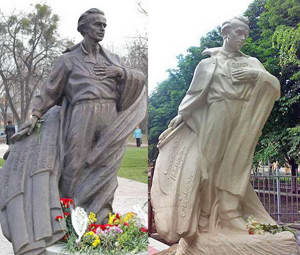How Taras Shevchenko has become Vasyl Symonenko’s “little brother”
Monuments have been found to be almost identical
Cherkasy residents are discussing the striking resemblance between two monuments, one to Symonenko in Cherkasy and another to Shevchenko in Novomyrhorod, Kirovograd oblast. Despite the fact that both sculptures were erected back in 2010, the news of their similarity has struck the locals these days only.
The consternation is caused by the fact that the monuments’ creator is Cherkasy sculptor Vladyslav Dymion. He was commissioned to make the Symonenko sculpture by Cherkasy mayor Serhii Odarych. While the artist was working on it, Novomyrhorod residents came to him asking to help in erecting the Shevchenko monument. So, the Shevchenko sculpture was unveiled in June 2010, while the Symonenko monument followed in Cherkasy a few months later, in November 2010. Both poets’ figures, composition, dynamics are all too similar. The authors look like twins, with identical hand on chest posture and a symbolic wing behind... However, Dymion still does not understand why the fact of resemblance has caused such a vigorous reaction.
“I have made the Symonenko monument first, as a sketch or a model, while the Shevchenko monument is simplified, unlike the Symonenko one. There is a big difference. Simply speaking, the Shevchenko sculpture carries the dynamic of fields, steppes and roads, while the Symonenko one is endowed with expressive wing. Clothing and details are all different. In addition, the Novomyrhorod monument was built of concrete, while its Cherkasy counterpart is bronze-cast,” The Day was told by the sculptor. When we asked him whether he had informed his customers that he was making a similar monument in Novomyrhorod, he replied that he had not because “I saw no need to tell such trifles.”
“No complaints are accepted as I did not sign any contracts stipulating that the monument should be unique. I agreed just for the sake of making the young Shevchenko sculpture. There was not enough time to change the composition. I strived to meet my customers’ requirements and had changed it a little. However, the Symonenko monument has an advantage over the second one, as the Novomyrhorod sculpture is inexpensive, small and made of concrete. It is the Symonenko’s monument’s little brother, looking like it, but not identical to it,” Dymion argues and adds that all this has nothing to do with plagiarism.
Meanwhile, Cherkasy residents believe this monument situation to be indicative of wider problems. Some people have very conveniently found so-called “mystic” explanations for the authorities’ failure to act and the community’s indifference to Symonenko. Allegedly, it is all because of Symonenko’s poem “The Curse,” cursing God and all the saints. This is the purported cause for the poet’s bad luck, as his name was assigned to the shortest street of Cherkasy, while the monument’s woes are even worse. They started to raise the funds for the erection of the monument back in 1989. Anatolii Voloshyn, then the city’s mayor, had unveiled the Symonenko monument with great pomp in 2006, just before the next elections, but that plaster sculpture was so ugly that the city’s intellectuals opposed such a mockery of the poet, and the monument has been simply demolished after a while.
COMMENTARIES
Serhii Odarych, the mayor of Cherkasy:
“This is unethical, to say the least. I am really sad about it. I have never met such thing before. The situation when the creator plagiarizes his own idea is beyond my comprehension. My contracts with Dymion contain no mention of the use of this idea or artistic solution in other projects, we have not discussed it, so I cannot even determine whether the author was entitled to do something like that. The monuments do differ significantly, but their overall similarity is obvious.”
Valentyna Kovalenko, head of Cherkasy Regional Branch of the Union of Writers of Ukraine:
“The true creator must be original. Actually, we have never saw originality in this monument. It is sad that everybody makes generous promises, but when the work has been finished, we are lucky to have received even that. Similarity is a good thing in discussing Symonenko’s works, as they continued Shevchenko’s tradition in a very deep, archetypical, symbolical way. However, it has no place in the case of creating monuments. They should show both poets’ faces, truly individual faces. For me, the only original monument to the poet is the grave one. I have yet to see a monument that would reflect the poet’s character in a deeper and more expressive way.”






